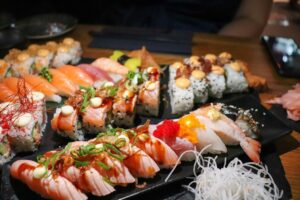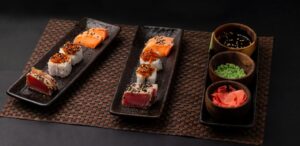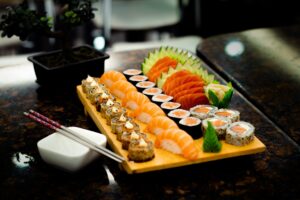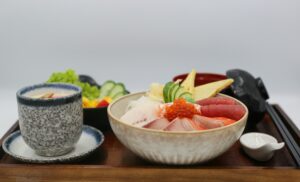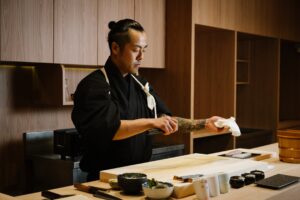
Japanese Food in Singapore: A Story of Trust and Tradition
Singapore’s identity as a global food capital is often told through its vibrant hawker centres, with storied dishes like Hainanese chicken rice and the iconic chilli crab. These hawker centres are a narrative of glorious, organised chaos—the sizzle of pork lard in a wok, the rhythmic chop of a cleaver, the aromatic steam rising from a bowl of bak kut teh. Yet, a quieter, equally profound culinary story has unfolded alongside it. The evolution of Japanese food in Singapore is a testament to tradition, precision, and an unspoken trust between chef and guest.
While many a food tour begins at a bustling food centre like Maxwell Food Centre or Old Airport Road Food Centre, the city’s Japanese dining scene offers a different kind of experience. It has grown from a niche option into an integral part of the nation’s gastronomic identity. From intimate omakase counters where silence is a key ingredient, to lively izakayas, Singapore restaurants have cultivated one of Asia’s most thoughtful Japanese culinary ecosystems outside of Japan itself.
This journey reflects a deep respect for authenticity and a quiet appreciation for craftsmanship, a stark contrast to the wonderful, democratic energy of the local coffee shop where one might enjoy kaya toast and soft boiled eggs for breakfast. The diversity of Japanese and local food options is a reflection of Singapore’s food culture, highlighting the country’s rich culinary heritage.
The Japanese Culinary Renaissance in Singapore
The journey of Japanese cuisine in Singapore is a story of quiet excellence. Unlike the foundational Chinese and Malay influences that shaped Singapore’s food culture from its colonial beginnings, Japanese traditions arrived as a sophisticated import during the economic boom of the 1980s. This was a deliberate introduction of a culinary philosophy rooted in centuries of practice. Today, with over 1,000 Japanese restaurants, this art form is deeply woven into the city’s fabric.
This growth is fundamentally different from the organic evolution of local favourites. While dishes like char kway teow and bak kut teh are classic examples of a Singaporean dish, each having evolved over generations in hawker stalls, shaped by migration and local tastes, Japanese restaurants hold to rigorous standards. Many source ingredients directly from Japan to honour traditional flavours, ensuring a piece of tuna tastes as it would in Tokyo.
This dedication was nurtured by Singapore’s discerning dining culture and a significant Japanese expatriate community. They introduced the city to chef-driven, seasonal dining that celebrates the purity of ingredients, a philosophy that resonates even with those accustomed to the complex savory flavors of Peranakan food or the rich spices of Indian food.

A Contrast of Culinary Philosophies: Hawker Centre vs. Omakase Counter
The contrast between a hawker centre and a Japanese omakase restaurant illuminates two different, yet equally valid, philosophies of Singapore food. A hawker stall is a theatre of controlled chaos—the clang of the wok cooking up an oyster omelette, the scent of dark soy sauce hitting a hot pan of stir fried noodles.
Many of these dishes are traditionally eaten as part of Singapore’s daily food culture, reflecting customs and practices passed down through generations. It is communal, accessible, and deeply embedded in the rhythm of daily life. It is here that a popular dish like bak chor mee, with its springy egg noodles and minced pork, is perfected through repetition and generational knowledge. The air is thick with the aroma of fragrant rice cooked in chicken fat, the base for the beloved chicken rice.
In contrast, the omakase counter is a space of stillness. The experience is intimate, almost reverential. The chef’s movements are precise, a quiet dance of knife against fish. The focus is on the ingredient in its purest form, its story told in a single, perfect bite. While a tour of the best hawker stalls offers a tapestry of flavours—from spicy chili sauce to sweet coconut milk—the omakase Singapore experience offers a deep, meditative dive into one. One is a celebration of community; the other, a conversation between chef, guest, and season. Both are cornerstones of food in Singapore.

History of Japanese Food in Singapore
While Japanese cuisine first made its appearance in Singapore before World War II, it wasn’t until the 1960s and 1970s that it began to take root in the city’s culinary landscape. Early Japanese restaurants, often tucked away in Orchard Road or Chinatown, introduced Singaporeans to the delicate artistry of sushi, sashimi, and tempura.
Their presence spurred a demand for authentic Japanese dining experiences, leading to a proliferation of restaurants in the central business district. These establishments became gathering spots not only for the Japanese community but also for Singaporeans eager to explore new culinary horizons.
By the 1990s, Japanese food had become more accessible than ever. The rise of food courts and hawker centers across the island brought Japanese favorites like ramen, udon, and bento sets to a wider audience. These venues, already beloved for their affordable and incredibly tasty local fare, now offered Singaporeans the chance to enjoy Japanese dishes alongside classics like fragrant rice cooked in chicken fat or a plate of fried chicken. The convenience and affordability of these options helped Japanese cuisine become a staple of everyday dining.
Today, Japanese cuisine is woven into the fabric of Singapore’s food culture, from high-end omakase counters to bustling food courts and hawker centers. Sushi and sashimi remain perennial favorites, while ramen and udon shops draw crowds with their comforting broths and springy noodles. Restaurants like Sushi Tei, with its wide range of sushi and sashimi, and Ramen Santouka, known for its rich, flavorful ramen, have become household names. Meanwhile, places like Tetsuya’s and Tsuruhashi Fugetsu showcase the breadth of Japanese culinary artistry, from contemporary fine dining to the savory flavors of Japanese street food.
Traditional Japanese Dining Experiences
True Japanese dining in Singapore extends far beyond the familiar territories of sushi and sashimi. It encompasses the refined world of kaiseki, where multi-course menus reflect the passing seasons with quiet artistry. These establishments are more than restaurants; they are cultural custodians, preserving a philosophy where each dish is a poem.
Even in a tropical climate, chefs honour the traditional Japanese calendar. Menus are built around ingredients flown in fresh from Japanese forests and seas. This could be spring’s first bamboo shoots, autumnal matsutake mushrooms, or the rich fat of winter yellowtail. The preservation of technique remains paramount. The careful aging of fish to develop umami, the precise temperature of the steamed rice, and the artful arrangement of each plate are all acts of intention. These establishments are quiet guardians of a culinary philosophy, offering a window into an appreciation for nature that rivals the complex spice blends found in local beef rendang or the slow-simmered broths of pork bones for ‘meat bone tea’ (bak kut teh).

Omakase Culture and Chef-Driven Experiences
The rise of omakase dining represents a profound shift in the city’s relationship with Japanese cuisine. Omakase, or “I’ll leave it to you,” is an invitation to trust. It is an agreement to surrender control and place the dining experience entirely in the chef’s hands. The result is a personal culinary journey guided by the day’s best ingredients and the chef’s intuition. In Singapore, this tradition is maintained with immense integrity, sometimes with subtle nods to the locale—perhaps the use of a tropical fruit as a palate cleanser.
For those new to omakase, the experience is enhanced by understanding its unspoken etiquette. Reservations are often made weeks in advance. Punctuality is a sign of respect. The meal is a conversation, and trusting the chef’s selections allows one to fully receive the story being told, piece by piece. It is a commitment to being present, a different kind of focus than that required to navigate the queues at a famous hawker centre.

Diverse Japanese Restaurant Categories
The depth of Japanese cuisine in Singapore reflects the city’s sophisticated palate. This diversity spans from simple food courts serving bento boxes to multi-course kaiseki experiences. Ramen and noodle houses have adapted beautifully, offering lighter broths alongside traditional tonkotsu to suit the tropical climate.
Izakaya culture has also found a natural home here. These casual pubs serve small plates, grilled skewers, and drinks, creating a relaxed atmosphere that aligns with the local after-work tradition of gathering at a coffee shop for an iced coffee or sweet milk tea sweetened with condensed milk. They serve as a bridge, offering an authentic yet accessible entry point into Japanese casual dining.
Best Japanese Restaurants Across Price Points
Authentic Japanese flavours are accessible at every level. Budget-friendly food court stalls offer satisfying donburi and curry rice. Some even serve a Japanese-style chicken cutlet with curry sauce, a comforting meal that feels distantly related to local favourites like fried chicken.
Mid-range restaurants form the heart of Singapore’s Japanese dining scene. They provide comprehensive menus with quality sushi, sashimi, and tempura, making authentic Japanese dining a regular pleasure.
At the highest end, restaurants like Shinji by Kanesaka, Sushi Sato, and Sushi Masa stand out for their dedication to tradition, ingredient quality, and a sense of quiet mastery. These counter-focused establishments receive premium seafood flown in daily from Toyosu Fish Market, allowing dishes such as otoro and sea urchin to reflect both season and origin. The understated atmosphere at each invites guests to slow down and savour every bite, making each omakase experience both intimate and memorable.
Ingredient Sourcing and Seasonality Trends
Maintaining authentic Japanese flavours is a feat of modern logistics. Singapore’s infrastructure allows restaurants to receive fresh seafood, premium wagyu, and delicate produce within 24 hours of harvest. This air-flown connection is the foundation of authentic Japanese dining in the city.
At the same time, a respectful hybridisation is occurring. Some chefs explore the dialogue between Japanese techniques and Southeast Asian ingredients. This might manifest as using local fish with Japanese curing methods or incorporating regional flavours like palm sugar or coconut cream into desserts. Ingredients such as glutinous rice are also sometimes incorporated into fusion desserts or savory dishes, reflecting the blending of culinary traditions and highlighting the unique sticky texture prized in both sweet and savory Asian confections.
This approach respects Japanese principles while acknowledging a sense of place. It’s a subtle nod to the fusion that defines much of Singapore’s food culture, from Peranakan dish creations to the mix of Indian and Malaysian cuisines.


Authentic Japanese Dining Beyond Sushi
While sushi is a beloved entry point, Singapore offers a chance to explore the vast landscape of Japanese culinary traditions, deepening cultural understanding.
From Hainanese Chicken Rice to Japanese Specialties
A diner who understands the subtle nuances of a perfectly cooked plate of local chicken rice—the texture of the flavorful rice, sometimes made with fragrant basmati rice in traditional meals, the tenderness of the poultry, the balance of the chilli sauce and sambal chili—possesses the palate to appreciate the regional specialties of Japan.
Local comfort foods also include crispy fried tofu as a savory accompaniment in dishes like rojak or ayam penyet, and braised duck, a signature dish known for its rich flavors and traditional preparation. Braised or roasted meats such as pork belly, prized for its crispy skin and juicy interior, are also favorites.
Restaurants focused on Hokkaido seafood celebrate the cold waters of Japan’s north, while those specializing in Kyushu ramen offer the rich, pork-bone broths of the south. Traditional comfort foods like oyakodon and katsu curry also resonate, offering homestyle flavours that connect with a palate accustomed to the comfort of a hawker meal, be it a bowl of yellow egg noodles with fish balls, fish cake, and tofu puffs for added texture and flavor, or a simple plate of fried carrot cake (chai tow kway), which is actually a steamed rice cake made from rice flour and radish, not the Western dessert. Classic Chinese cuisine also features stuffed vegetables or tofu with fish paste, braised in savory sauces.
Specialized Japanese Culinary Arts
Beyond the main categories, Singapore is home to masters of specific Japanese culinary arts. Tempura specialists demonstrate a demanding craft at intimate counters. The batter is feather-light, the oil temperature exact. Each piece must be eaten immediately, a fleeting moment of perfection.
Teppanyaki offers a more theatrical experience, combining entertainment with the preparation of premium wagyu. For a moment of stillness, traditional tea ceremony venues provide a deeper immersion into Japanese aesthetics, often accompanied by delicate sweets. The world of sake and Japanese whisky has also found a sophisticated audience, with dedicated bars guiding guests through pairings that elevate both drink and dish. This is a far cry from the simple pleasure of toasted bread with kaya, but shares a common thread of focused appreciation.
The Future of Japanese Cuisine in Singapore
The evolution continues, guided by a new generation of chefs. A key trend is the balance between fusion and authenticity, creating distinctly “Singaporean-Japanese” dishes that honour both cultures. This is not the confused fusion of the past, but a thoughtful incorporation of local ideas into a traditional Japanese framework.
A new generation of Singapore-based chefs, many trained in Japan but shaped by a multicultural environment, is bringing fresh perspectives. They blend traditional techniques with local sensibilities. Sustainability is also a central focus. Restaurants are supporting responsible fishing and reducing waste through nose-to-tail cooking, reflecting a growing consciousness that true luxury lies in respect for nature. It’s an ethos that feels right at home in a city that celebrates everything from a humble bowl of rice noodles to a multi-course feast.

Navigating the Scene from Hawker Food Centre to Omakase
For food enthusiasts, navigating Singapore’s dining landscape is a journey. A food tour might lead you to a famous hawker centre for char kway teow—those delicious flat rice noodles stir-fried with dark soy sauce, egg, and sometimes Chinese sausage. Don’t miss the iconic chili crab, a beloved Singaporean seafood dish featuring crab coated in a rich, tangy, and mildly spicy tomato-chili sauce, popular with both locals and tourists. For dessert, try local favorites like Ice Kachang or ice cream sandwiches, where sweet corn is often added as a unique and tasty ingredient. But securing a seat at a top Japanese restaurant requires planning. Unlike the easy access to street food, many omakase experiences require reservations far in advance.
Identifying quality comes down to observing quiet details: attention to ingredient sourcing, the precision of the chef’s knife work, and a seasonal menu. The integration of Japanese cuisine into Singapore’s food culture is not just another international option. It demonstrates a rare capacity to embrace and uphold authentic traditions, creating a space where ancient technique meets thoughtful adaptation. It is a testament to a city that not only loves to eat but also knows how to listen.

